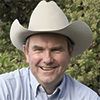The animals in the photos of today’s show ring winners look vastly superior to those in my day back in the ’60s. Not a hair is out of place on the beautiful animals, and that’s because literally behind every show ring winner stands an army of burly young men: the fitters who got the animal looking that way.
At a show once, I overheard one mother brag to another mom about her son, who had become a head and neck specialist. The other mom said, “You must be so proud that your son is a doctor.”
To which the proud mom replied, “Who said anything about him being a doctor? He clips show steers and heifers!”
You have the tail specialist, the left back leg specialist and the brisket specialist. I wouldn’t be surprised to find there was a guy whose job was solely to clip eyebrows and nose hairs. To which I say: “Where were these guys when I needed them?”
When I showed steers, if the fair board caught a parent or other person even brushing their child’s animal, it would be unceremoniously kicked out of the fair. Which meant I had to do all the work, all without getting my white show pants and FFA jacket dirty. Today’s kids don’t even have to wear the uniform.
Admittedly, we didn’t do near the work on our steers. Pretty much it was limited to clipping the head and belly before the fair, fluffing the tail, putting black shoe polish on your steer’s hooves and using a “liner” to make long lines in the animal’s hair that we brushed up to get a curled effect.
It supposedly made your animal look longer, but in hindsight, it deserved to disappear along with the butch haircut for boys and the beehive hairdo for women.
Now the steer show business is big business, and today’s showmen have at their disposal a vast array of tools and products, including blocking chutes and a variety of sprays and adhesives from Sullivan’s Show Supply.
In one photo, I recently saw one young girl who was about 3 feet tall and she had four winning animals, all at the same show: two steers and two heifers, and they all were gorgeously fitted and appeared very calm.
Believe me, if I’d have tied my first man-killing steer, Old Abe, in a blocking chute he’d have drug that thing all over the fairgrounds. One animal at a time was all I could handle because I had to hog-tie him just to get a halter on Old Abe.
Kids get a lot more money for their winning animals than we ever did. I showed two county fair grand champions and got $1.25 a pound for one and $2.10 for the other, but I made money because I bought them right off a ranch for commercial prices. (I got Old Abe even cheaper because the owner was afraid he’d kill someone and wanted to get rid of him.)
Nowadays you hear of prospect calves bringing $10,000 and grand champions fetching $100,000. I sure could have used some of that action.
I don’t know which is better for the kids. More kids are involved nowadays, which means more kids are learning valuable life lessons and aren’t stuck in the house playing video games. But I don’t think poor kids like me could have ever competed.
My mom certainly didn’t know anything about cattle, and I didn’t have nine friends to help me get my calf ready either. And I certainly did not have a single good-enough friend who was willing to get behind Old Abe’s rear legs and turn on a pair of clippers. ![]()









